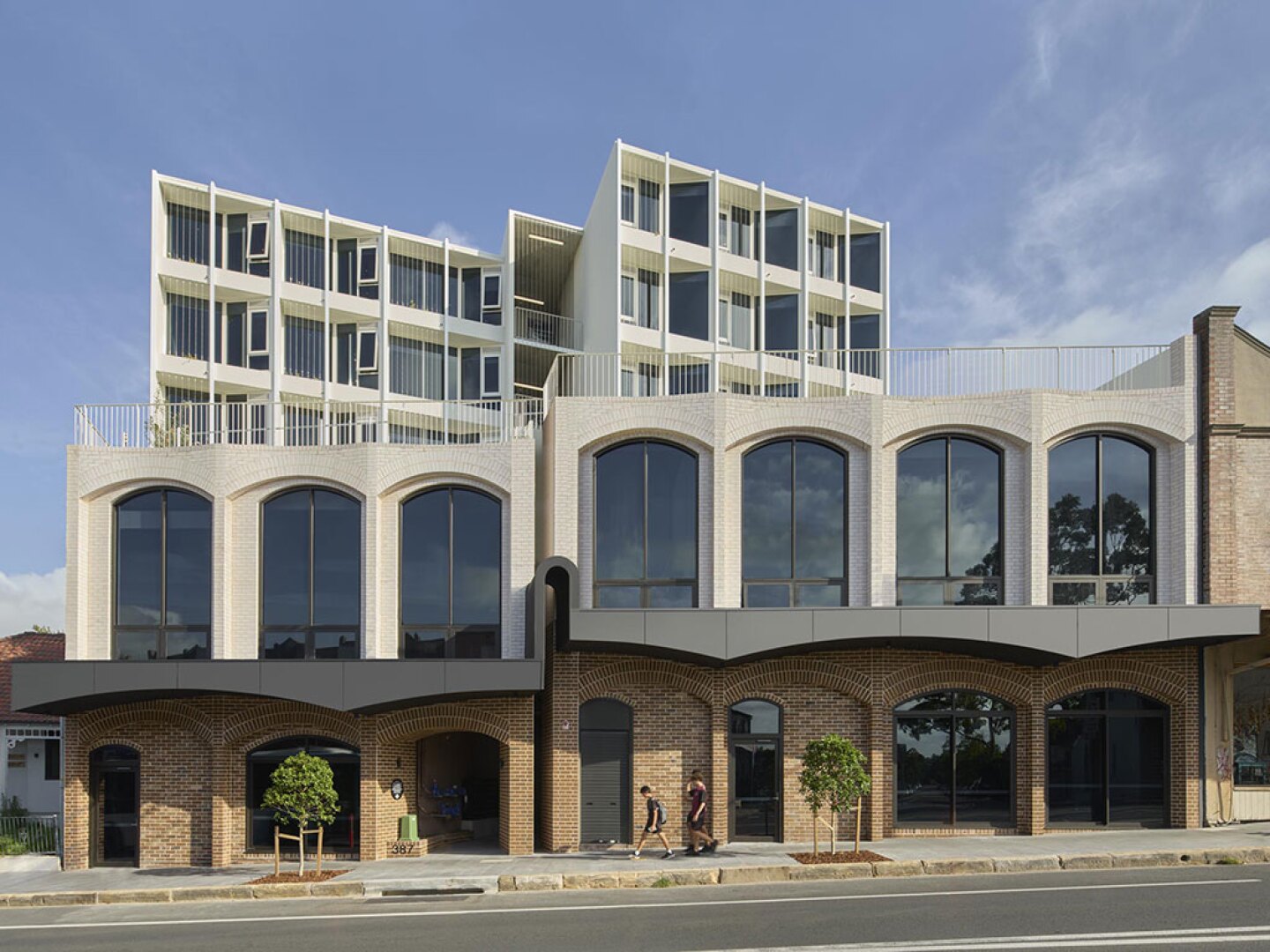
As cities grapple with the high costs of housing, Nightingale Marrickville offers a replicable model that combines environmental sustainability, social cohesion, and economic accessibility while also providing a level of housing stability rarely possible in affordable housing. The project has sparked interest from other faith-based organizations seeking to repurpose underused properties.
(SJB/Fresh Hope Communities)
Type: Mixed-Use Residential, Affordable Housing
Developer: Fresh Hope Communities and Nightingale Housing
Owner: Fresh Hope Communities (Churches of Christ Property Trust)
Designers: SJB
Site Size: 0.19 acres (0.08 ha)
Date Opened: February 1, 2024
Date Completed: December 31, 2023
Housing: 54 units
Parking (number of spaces): 12
Open Space: 1,076 square feet (100 sq m)
In the Sydney suburb of Marrickville, two not-for-profit organizations—Fresh Hope Communities, the public benevolent institution entity of churches of Christ in New South Wales and the Australian Capital Territory; and Nightingale Housing of Brunswick, Victoria—came together to develop a building that holds 54 units renting at 80 percent of market rates, as well as two community-focused commercial spaces. The Churches of Christ Property Trust has provided a 99-year lease for the land, which allows the units to remain affordable far beyond a more typical 10-year period.
Dedicated to developing socially, financially, and environmentally sustainable houses, Nightingale Housing had not previously created built-to-rent offerings, whereas Fresh Hope Communities had been seeking an opportunity to create a built-to-rent product in the Sydney market, says David Tolman, general manager, group accommodation and housing at Fresh Hope Communities. “As a religious entity, we’re about community,” he says. “We run retirement living communities, we provide aged care, we provide group accommodations.” The project in Marrickville let Fresh Hope repurpose a vacant church property and provide apartments at reduced rental rates.
The challenge of fitting 54 units, plus community and commercial spaces, on a small site required creative architectural solutions, says Gabrielle Suhr, senior associate of SJB. The design had to accommodate a setback from the street front to reference the existing scale of the adjacent Victorian terrace shops while incorporating a six-story building at the rear of the site.
In addition, the site slopes in two directions—toward busy Illawarra Road on one side and toward a rear laneway on the other. “So, we split the building into two volumes, with [fewer] than 30 keys in each,” Suhr says. Central stairs lead to level one, the communal space. “We split level one so that it had two communal areas with the same offerings—a large kitchen, a large living and dining space, and an outdoor living space.” As it worked out, residents use one of the two areas as a communal space, “where everyone cooks together, shares reality TV nights, or works on communal puzzles . . . the other space they can book for larger social functions,” she says. “Apparently, it’s booked quite a lot.”
Each unit maximizes its approximately 270 square feet (about 25 sq m) through careful design choices that encourage community interaction. The architects initially considered Murphy beds but found them impractical. “They’re very heavy and difficult to use,” Suhr says. Instead, they provided a more flexible space with efficient layouts and large windows that offer views of Marrickville’s terracotta-tiled houses to the south and the city skyline to the north.
A key innovation was the peg board system—a plywood wall with insertable dowels and shelving that has proved extremely popular with residents. “The building manager has had to provide more and more shelves for people,” Suhr says, because residents use them creatively for storing books or kitchen items, hanging coats, or holding a television.
The project’s success relied on using New South Wales’ boarding house provisions, which enabled the building to accommodate more rooms on each floor than otherwise would be achievable with apartments. “The units are similar to a small hotel room in size, but unlike a typical boarding house, they each have their own kitchenette and their own bathroom,” Tolman says. These provisions allowed greater density while reducing development costs.
The boarding house classification also let the developers reduce conventional parking requirements, which would have required one parking space per person. Instead, Nightingale Marrickville provides access to shared cars through a third-party car rental company. There are also spaces for bicycle and motorbike parking. The reduced parking requirements were justified by the site’s proximity to public transport and the target demographic’s transportation needs.
The ground-floor commercial spaces help activate the street. One will be dedicated to arts and culture and offer an affordable place for local artists to exhibit work and run creative workshops for residents, as well as for the wider community. The other houses a social enterprise café to be operated by local restaurateurs. “We hope the café will also offer cooking classes to residents,” Tolman says. “Both commercial spaces will operate as not-for-profit entities. They are about catalyzing community.”
Sustainability weaves through nearly every aspect of the development. The nearby Marrickville train station puts the city a 20-minute commute away. Material choices reflect both environmental and budget considerations. The team specified locally made products where possible. Designers left concrete structural walls exposed, avoiding unnecessary finishes, and used low–volatile organic compound paint where necessary. The building operates without gas, generates electricity via solar panels, and incorporates native plantings and green façades.
Both a community engagement manager and a residence manager live on site, and they are tasked with actively cultivating connection among residents through gallery exhibitions, events, and workshops. The community-building success has exceeded expectations, Suhr says: “Considering [the building’s] only a year old, the residents’ pride in [it] has been beautiful to witness.”
Fifty percent of the units are reserved for priority groups including Aboriginal and Torres Strait Islanders, single women age 55 or older, individuals with disabilities, and key community contributors. All residents must meet income thresholds, with rents 20 percent lower than market value.
The project has sparked interest from other faith-based organizations seeking to repurpose underused properties. “We’re now having discussions with different denominations to talk about what we’ve done and how we did it,” Tolman says.
As cities grapple with the high costs of housing, Nightingale Marrickville offers a replicable model that combines environmental sustainability, social cohesion, and economic accessibility while also providing a level of housing stability rarely possible in affordable housing. The project demonstrates how innovative partnerships, regulatory creativity, and community-focused design can create thriving communities that enhance the broader fabric of a neighborhood.








